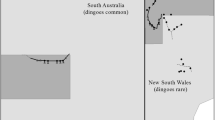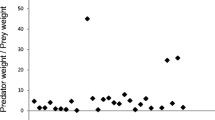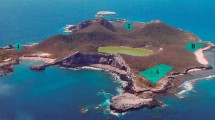Abstract
Medium-sized mammalian predators (i.e. mesopredators) on islands are known to have devastating effects on the abundance and diversity of terrestrial vertebrates. Mesopredators are often highly omnivorous, and on islands, may have access not only to terrestrial prey, but to marine prey as well, though impacts of mammalian mesopredators on marine communities have rarely been considered. Large apex predators are likely to be extirpated or absent on islands, implying a lack of top-down control of mesopredators that, in combination with high food availability from terrestrial and marine sources, likely exacerbates their impacts on island prey. We exploited a natural experiment—the presence or absence of raccoons (Procyon lotor) on islands in the Gulf Islands, British Columbia, Canada—to investigate the impacts that this key mesopredator has on both terrestrial and marine prey in an island system from which all native apex predators have been extirpated. Long-term monitoring of song sparrow (Melospiza melodia) nests showed raccoons to be the predominant nest predator in the Gulf Islands. To identify their community-level impacts, we surveyed the distribution of raccoons across 44 Gulf Islands, and then compared terrestrial and marine prey abundances on six raccoon-present and six raccoon-absent islands. Our results demonstrate significant negative effects of raccoons on terrestrial, intertidal, and shallow subtidal prey abundance, and point to additional community-level effects through indirect interactions. Our findings show that mammalian mesopredators not only affect terrestrial prey, but that, on islands, their direct impacts extend to the surrounding marine community.






Similar content being viewed by others
References
Atkinson IAE (2001) Introduced mammals and models for restoration. Biol Conserv 99:81–96
Banks PB, Nordström M, Ahola M, Salo P, Fey K, Korpimäki E (2008) Impacts of alien mink predation on island vertebrate communities of the Baltic Sea Archipelago: review of a long-term experimental study. Boreal Environ Res 13:3–16
Behrens Yamada S, Boulding EG (1996) The role of highly mobile crab predators in the intertidal zonation of their gastropod prey. J Exp Mar Biol Ecol 204:59–83
Blackburn TM, Cassey P, Duncan RP, Evans KL, Gaston KJ (2004) Avian extinction and mammalian introductions on oceanic islands. Science 305:1955–1958
Blackburn TM, Petchey OL, Cassey P, Gaston KJ (2005) Functional diversity of mammalian predators and extinction in island birds. Ecology 86:2916–2923
Brashares JS, Prugh LR, Stoner CJ, Epps CW (2010) Ecological and conservation implications of mesopredator release. Trophic cascades: predators, prey, and the changing dynamics of nature. Island Press, Washington, DC, pp 221–240
Brown JH (1971) Mammals on mountaintops: nonequilibrium insular biogeography. Am Nat 105:467–478
Burbidge AA, Manly BFJ (2002) Mammal extinctions on Australian islands: causes and conservation implications. J Biogeogr 29:465–473
Carbone C, Teacher A, Rowcliffe JM (2007) The costs of carnivory. PLoS Biol 5:22
Carlton JT, Hodder J (2003) Maritime mammals: terrestrial mammals as consumers in marine intertidal communities. Mar Ecol Prog Ser 256:271–286
Chamberlain-Auger JA, Auger PJ, Strauss EG (1990) Breeding biology of American crows. Wilson Bull 102:615–622
Courchamp F, Chapuis J-L, Pascal M (2003) Mammal invaders on islands: impact, control and control impact. Biol Rev 78:347–383
Crooks KR, Soulé ME (1999) Mesopredator release and avifaunal extinctions in a fragmented system. Nature 400:563–566
Darimont CT, Paquet PC (2002) Gray wolves, Canis lupus, of British Columbia’s Central and North Coast: distribution and conservation assessment. Can Field Nat 116:416–422
deFur PL, McMahon BR (1984) Physiological compensation to short-term air exposure in red rock crabs, Cancer productus Randall, from littoral and sublittoral habitats. I. Oxygen uptake and transport. Physiol Zool 57:137–150
Dill LM, Heithaus MR, Walters CJ (2003) Behaviorally mediated indirect interactions in marine communities and their conservation implications. Ecology 84:1151–1157
Elbroch LM, Saucedo C, Wittmer HU (2010) Swimming by pumas (Puma concolor) in Patagonia: rethinking barriers to puma movement. Stud Neotrop Fauna E 45:187–190
Ellis JC, Chen W, O’Keefe B, Shulman MJ, Witman JD (2005) Predation by gulls on crabs in rocky intertidal and shallow subtidal zones of the Gulf of Maine. J Exp Mar Biol Ecol 324:31–43
Ellis JC, Shulman MJ, Wood M, Witman JD, Lozyniak S (2007) Regulation of intertidal food webs by avian predators on New England rocky shores. Ecology 88:853–863
Elmhagen B, Ludwig G, Rushton SP, Helle P, Lindén H (2010) Top predators, mesopredators and their prey: interference ecosystems along bioclimatic productivity gradients. J Anim Ecol 79:785–794
Estes JA, Terborgh J, Brashares JS, Power ME, Berger J, Bond WJ, Carpenter SR, Essington TE, Holt RD, Jackson JBC et al (2011) Trophic downgrading of planet earth. Science 333:301–306
Field RD, Reynolds JD (2011) Sea to sky: impacts of residual salmon-derived nutrients on estuarine breeding bird communities. Proc R Soc B 278:3081–3088
Fontaine JJ, Martin TE (2006) Parent birds assess nest predation risk and adjust their reproductive strategies. Ecol Lett 9:428–434
Forsman JT, Mönkkönen M, Korpimäki E, Thomson RL (2013) Mammalian nest predator feces as a cue in avian habitat selection decisions. Behav Ecol 24:262–266
Galetti M, Bovendorp RS, Fadini RF, Gussoni COA, Rodriques M, Alvarez AD, Guimarães PR, Alves K (2009) Hyper abundant mesopredators and bird extinction in an Atlantic forest island. Zoologia 26:288–298
Gehrt SD (2003) Raccoon (Procyon lotor and allies). In: Feldhammer GA, Thompson BC, Chapman JA (eds) Wild mammals of North America: biology, management, and conservation, 2nd edn. John Hopkins University Press, Baltimore, pp 611–634
Golumbia T (2006) A history of species introductions in Gwaii Haanas and Gulf Islands National Park Reserves in British Columbia, Canada: implications for management. Trans W Sect Wildl Soc 42:20–34
Hansen B, Searle R, Szaniszlo W, Munro S (2010) Learning to live with large carnivores. WildCoast project primer and guidelines. Parks Canada Agency, Canada
Hartman LH, Eastman DS (1999) Distribution of introduced raccoons Procyon lotor on the Queen Charlotte Islands: implications for burrow-nesting seabirds. Biol Conserv 88:1–13
Hudgens BR, Garcelon DK (2011) Induced changes in island fox (Urocyon littoralis) activity do not mitigate the extinction threat posed by a novel predator. Oecologia 165:699–705
Hutto RL, Pletschet SM, Hendricks P (1986) A fixed-radius point count method for nonbreeding and breeding season use. Auk 103:593–602
Irons DB, Anthony RG, Estes JA (1986) Foraging strategies of glaucous-winged gulls in a rocky intertidal community. Ecology 67:1460–1474
Iverson JB (1978) The impact of feral cats and dogs on populations of the West Indian rock iguana, Cyclura carinata. Biol Conserv 14:63–73
Jewell KJ, Arcese P, Gergel SE (2007) Robust predictions of species distribution: spatial habitat models for a brood parasite. Biol Conserv 140:259–272
Johnson CN, Isaac JL, Fisher DO (2007) Rarity of a top predator triggers continent-wide collapse of mammal prey: dingoes and marsupials in Australia. Proc R Soc B 274:341–346
Karels TJ, Byrom AE, Boonstra R, Krebs CJ (2000) The interactive effects of food and predators on reproduction and overwinter survival of arctic ground squirrels. J Anim Ecol 69:235–247
Krebs CJ, Boutin S, Boonstra R, Sinclair AR, Smith JN, Dale MR, Martin K, Turkington R (1995) Impact of food and predation on the snowshoe hare cycle. Science 269:1112–1115
Kurle CM, Croll DA, Tershy BR (2008) Introduced rats indirectly change marine rocky intertidal communities from algae- to invertebrate-dominated. P Natl Acad Sci USA 105:3800–3804
Lima SL (1998) Stress and decision making under the risk of predation: recent developments from behavioral, reproductive, and ecological perspectives. Adv Stud Behav 27:215–290
Lima SL (2009) Predators and the breeding bird: behavioral and reproductive flexibility under the risk of predation. Biol Rev 84:485–513
Lima SL, Dill LM (1990) Behavioral decisions made under the risk of predation: a review and prospectus. Can J Zool 68:619–640
Lindzey FG, Meslow EC (1977) Home range and habitat use by black bears in Southwestern Washington. J Wildl Manage 41:413–425
Marquet PA, Taper ML (1998) On size and area: patterns of mammalian body size extremes across landmasses. Evol Ecol 12:127–139
Morley CG, Winder L (2013) The effect of the small Indian mongoose (Urva auropunctatus), island quality and habitat on the distribution of native and endemic birds on small islands within Fiji. PLoS One 8:53842
Polis GA, Hurd SD (1996) Linking marine and terrestrial food webs: allochthonous input from the ocean supports high secondary productivity on small islands and coastal land communities. Am Nat 147:396–423
Polis GA, Strong DR (1996) Food web complexity and community dynamics. Am Nat 147:813–846
Polis GA, Anderson WB, Holt RD (1997) Toward an integration of landscape and food web ecology: the dynamics of spatially subsidized food webs. Annu Rev Ecol Syst 28:289–316
Prugh LR, Stoner CJ, Epps CW, Bean WT, Ripple WJ, Laliberte AS, Brashares JS (2009) The rise of the mesopredator. Bioscience 59:779–791
Ripple WJ, Wirsing AJ, Wilmers CC, Letnic M (2013) Widespread mesopredator effects after wolf extirpation. Biol Conserv 160:70–79
Ritchie EG, Johnson CN (2009) Predator interactions, mesopredator release and biodiversity conservation. Ecol Lett 12:982–998
Robles C, Sweetnam DA, Dittman D (1989) Diel variation of intertidal foraging by Cancer productus L. in British Columbia. J Nat Hist 23:1041–1049
Rogers CM, Caro MJ (1998) Song sparrows, top carnivores and nest predation: a test of the mesopredator release hypothesis. Oecologia 116:227–233
Rose MD, Polis GA (1998) The distribution and abundance of coyotes: the effects of allochthonous food subsidies from the sea. Ecology 79:998–1007
Salo P, Nordström M, Thomson RL, Korpimäki E (2008) Risk induced by a native top predator reduces alien mink movements. J Anim Ecol 77:1092–1098
Schmidt KA (2003) Nest predation and population declines in Illinois songbirds: a case for mesopredator effects. Conserv Biol 17:1141–1150
Schmidt KA, Whelan CJ (1999) Nest predation on woodland songbirds: when is nest predation density dependent? Oikos 87:65–74
Schmitz OJ, Krivan V, Ovadia O (2004) Trophic cascades: the primacy of trait-mediated indirect interactions. Ecol Lett 7:153–163
Scrosati R, Heaven C (2007) Spatial trends in community richness, diversity, and evenness across rocky intertidal environmental stress gradients in eastern Canada. Mar Ecol Prog Ser 342:1–14
Small M, Hunter M (1988) Forest fragmentation and avian nest predation in forested landscapes. Oecologia 76:62–64
Soulé ME, Bolger DT, Alberts AC, Wrights J, Sorice M, Hill S (1988) Reconstructed dynamics of rapid extinctions of chaparral-requiring birds in urban habitat islands. Conserv Biol 2:75–92
Stapp P, Polis GA (2003) Marine resources subsidize insular rodent populations in the Gulf of California, Mexico. Oecologia 134:496–504
Terborgh J, Lopez L, Nuñez P, Rao M, Shahabuddin G, Orihuela G, Riveros M, Ascanio R, Adler GH, Lambert TD, Balbas L (2001) Ecological meltdown in predator-free forest fragments. Science 294:1923–1926
Towns DR, Atkinson IAE, Daugherty CH (2006) Have the harmful effects of introduced rats on islands been exaggerated? Biol Invasions 8:863–891
Travers M, Clinchy M, Zanette L, Boonstra R, Williams TD (2010) Indirect predator effects on clutch size and the cost of egg production. Ecol Lett 13:980–988
Weidinger K (2002) Interactive effects of concealment, parental behaviour and predators on the survival of open passerine nests. J Anim Ecol 71:424–437
Wilcove DS (1985) Nest predation in forest tracts and the decline of migratory songbirds. Ecology 66:1211–1214
Wilson RR, Blankenship TL, Hooten MB, Shivik JA (2010) Prey-mediated avoidance of an intraguild predator by its intraguild prey. Oecologia 164:921–929
Zanette L, Jenkins B (2000) Nesting success and nest predators in forest fragments: a study using real and artificial nests. Auk 117:445–454
Zanette L, Smith JNM, van Oort H, Clinchy M (2003) Synergistic effects of food and predators on annual reproductive success in song sparrows. Proc R Soc Lond B 270:799–803
Zanette L, Clinchy M, Smith JNM (2006) Combined food and predator effects on songbird nest survival and annual reproductive success: results from a bi-factorial experiment. Oecologia 147:632–640
Zanette LY, White AF, Allen MC, Clinchy M (2011) Perceived predation risk reduces the number of offspring songbirds produce per year. Science 334:1398–1401
Zanette LY, Hobson KA, Clinchy M, Travers M, Williams TD (2013) Food use is affected by the experience of nest predation: implications for indirect predator effects on clutch size. Oecologia 172:1031–1039
Zavaleta ES, Hobbs RJ, Mooney HA (2001) Viewing invasive species removal in a whole-ecosystem context. Trends Ecol Evol 16:454–459
Zuur AF, Ieno EN, Walker NJ, Saveliev AA, Smith GM (2009) Mixed effects models and extensions in ecology with R. Springer, New York
Acknowledgments
We thank the numerous field crews that assisted in collecting the camera data concerning raccoon predation on song sparrow nests, and in particular M. C. Allen, M. Travers and A. F. White. A. Currie, T. Diesch and D. Hope provided field assistance in the Gulf Islands, and we thank J. Sibbald for assistance in Clayoquot Sound. Thanks to Parks Canada, BC Parks and the owners of Coal, Domville, James, Moresby and Mowgli islands for access to the sites; and T. Golumbia and B. Clinchy for their support. Two anonymous reviewers provided helpful comments on the manuscript. Funding was provided by Natural Sciences and Engineering Research Council of Canada Discovery grants to M. C., L. Y. Z. and L. M. D., in addition to a Premier’s Research Excellence Award and Canada Foundation for Innovation grant to L. Y. Z. This work was approved by the Animal Care Committees of the University of Western Ontario and University of Victoria and conforms to the legal requirements of Canada.
Author information
Authors and Affiliations
Corresponding author
Additional information
Communicated by Christopher N. Johnson.
Rights and permissions
About this article
Cite this article
Suraci, J.P., Clinchy, M., Zanette, L.Y. et al. Mammalian mesopredators on islands directly impact both terrestrial and marine communities. Oecologia 176, 1087–1100 (2014). https://doi.org/10.1007/s00442-014-3085-5
Received:
Accepted:
Published:
Issue Date:
DOI: https://doi.org/10.1007/s00442-014-3085-5




